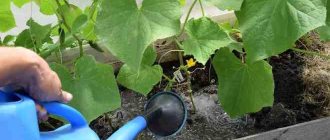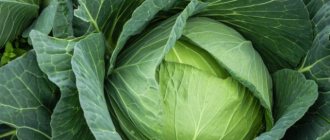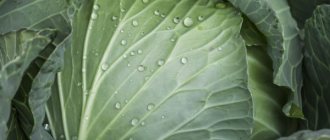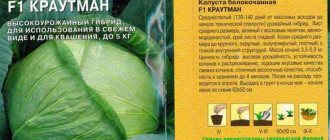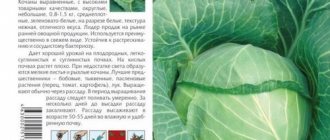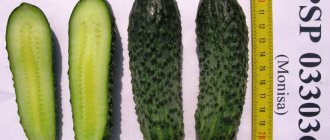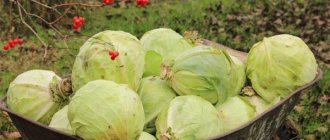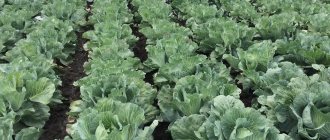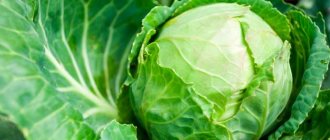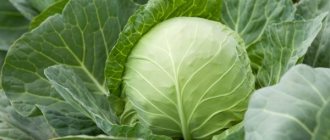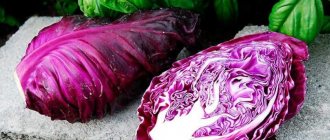Vegetable growing » Cabbage
1
1215
Article rating
Kira Stoletova
Langedeyker cabbage is a popular variety of German selection. The variety is characterized by excellent yields, long shelf life and high taste.
Description of Langedijker cabbage
Description of the variety
As noted above, this is a late-ripening variety. From the moment the first shoots appear until harvest, 140-170 days pass. Or 120-125 days after planting seedlings in the exhaust zone.
Langedijker's cabbage heads are dense, oval in shape with excellent internal structure. Not prone to cracking. The color of the head of cabbage is dark green. The average weight of a technically mature vegetable is in the range of 2-4.4 kg.
Cabbage yield is in the range of 9-10 kg per 1 m2.
The variety is excellent for consumption both fresh and for processing. Also, it is stored in the cellar for quite a long time, until the month of May (without loss of taste and commercial qualities).
It is recommended to grow this variety either in seedlings or by sowing seeds in special pots or boxes and then planting them in the ground.
Adapter F1
Manufacturer S&G (Syngenta Seeds) Culture Cabbage Plant type White cabbage Direction Long-term storage, Processing Cultivation Open ground Ripening (seedlings) 110-120 days Head/head; color Grey-green Head/head; shape Round Head/head; weight 2.0-5.0 kg Storage 3-6 months Disease resistance Fusarium Country Holland Recommended density 35-40 thousand pieces/ha Year of registration 2009
DESCRIPTION
growing season 115-120 days head weight 3-4 kg round-shaped head hybrid with high growth vigor resistant to damage by thrips resistant to fusarium
Purpose
Fresh sales, processing and storage (up to 6 months)
Additional Information
Standing density is 30-40 thousand plants/ha. The hybrid tolerates a lack of nitrogen nutrition well. It is perfectly preserved in the field throughout the harvesting period. It has high commercial and taste qualities and meets all standards for pickling hybrids.
- Cabbage, variety Ankoma RC F1
- Cabbage, Hurricane F1 variety
- Cabbage, variety Etma RC F1
- Cabbage, variety Tobia F1
- Cabbage, variety Kilaton F1
- Cabbage, variety Magnus F1
- Cabbage, variety Vestri F1
- Cabbage, variety Kevin F1
- Cabbage, variety Atria F1
The page was found by the following queries:
- cabbage adapter
- 2114 G44ivX1tcCXztYQmejYXIf6p6txemN-l2YPVQhCmOatUMj_kZiojCpQ2mJvrMwdTuaI3HUnitZR_go20yRxWEj_ICbNkz1lf0GVGx6Ba_aA 03f04fbc8ad0926c2b52db6cb0ff 46180405d306
- 2114 gtIc8MjLHguuCSJZOJ4lYsakpNjJtbkHe1kN8R9006JEAUW3aNfx7RdGJMwitza4C5HgzJkfkMgw9tp6_u6JvA 1ef69c8b958ef535222b45e009fb7ce32262f36f
- cabbage adapter
- cabbage adapter description reviews
In stock: 10000 pcs.
High ductility and excellent quality. It is possible to obtain ideal heads of cabbage for the supermarket weighing 2–2.5 kg.
Standing density is 30–40 thousand plants/ha. The hybrid tolerates a lack of nitrogen nutrition well. It is perfectly preserved in the field throughout the entire harvesting period. With a planting density of 40 thousand plants/ha, you can get ideal heads of cabbage for the supermarket weighing 2–2.5 kg.
Manufacturer: Syngenta (Switzerland)
Ripening (early ripening): Mid-late
Vegetative period, days: 115–120
Purpose: Fresh sale, processing and storage for up to 6 months.
Fetal weight: 3.0-4.0 kg
Fruit shape: rounded head
Seeding rate, ha: 30-40 thousand.
Fruit color: gray-green with a waxy coating of intensity to strong
Flesh color: Whitish when cut
Name of variety (hybrid): Adapter F1
Resistance: resistant to thrips damage, resistant to fusarium
Storage: up to 6 months
State Register of Breeding Achievements of the Russian Federation: The hybrid is included in the State Register for the Central (3) region. Recommended for fresh use and short-term storage. Medium late. The rosette of leaves is raised. The leaf is medium-sized, gray-green, with a waxy coating of medium intensity to strong, vesicular, slightly wavy along the edge. The head of cabbage is round-flat, covered, and whitish when cut. Outer and inner stumps of medium length. Head weight is 1.8-2.3 kg, density - 4.2 points. The taste is good. Marketable yield is 280-342 c/ha, at the level of the Gift standard. Maximum yield 600 c/ha (Moscow region). The yield of marketable products is 88%. Resistant to fusarium wilt
Plant: hybrid with high vigor. Medium-sized leaf, gray-green, with a waxy coating of medium intensity to strong, vesicular, slightly wavy along the edge. The head of cabbage is round-flat, covered, and whitish when cut. Outer and inner stumps of medium length
Code (according to the State Register): 9253077
Year of inclusion in the State Register: 2010
Regions of admission (State Register): NORTH-WESTERN, CENTRAL, CENTRAL-CHERNOZEM, NORTH-CAUCASIAN, LOWER VOLGA, FAR EASTERN
Link to the State Register: https://reestr.gossort.com/reestr/sort/9253077
Advantages and disadvantages of cabbage
Due to its advantages, this variety is still a favorite for many summer residents, even despite great competition from hybrids. Among the main advantages of Langedijker it is worth noting the following:
- The heads of cabbage are quite large (up to 4.4 kg), dense with excellent internal structure. Due to their density, they are easy to transport over long distances without losing their commercial qualities.
- The harvest is stored for a very long time, which is a definite advantage both when grown on an industrial scale and for personal use.
- Cabbage is universal in terms of consumption. It can be fermented, or it can be used raw, adding to salads.
- Heads of cabbage are resistant to cracking.
- The variety is resistant to vascular and mucous bacteriosis.
Sowing seeds for seedlings
Langedijker seeds should be sown for seedlings approximately March 10-20. Seeds are placed in a pre-prepared substrate to a depth of 1 to 1.5 cm. In warm regions of the country, it is possible to sow seeds in exhaust gas under film in April. The required temperature for seed germination is +4-5 degrees Celsius.
We also recommend reading: Description of the Losinoostrovskaya cabbage variety
After the seedlings have grown, they need to be planted in the exhaust gas. This is done approximately May 10-20. The planting pattern for this late cabbage is 35x60 cm. By the time the seedlings are planted in open ground, their height should be at least 12 cm.
Growing rules
Langedijker cabbage is grown both from seedlings and from seeds.
Seedless method
Growing without seedlings involves planting purchased seeds in a permanent place at the beginning of May. Before this, it is important to make sure that the soil has warmed up to a temperature of 14°C. After planting the seeds according to the 40 x 50 cm pattern, the rows are covered with plastic film: this speeds up the germination process.
Seedling method
Planting using seedlings begins with purchased seeds being planted in containers. This procedure is carried out in mid-March. The distance between the seeds should be 5-7 cm. After this, the container is placed in a warm place, the temperature of which is 20-25°C. This allows you to speed up the appearance of the first shoots. As soon as the seedlings have appeared, the temperature is lowered to 15°C during the day and 8°C at night.
Planting of seedlings in a permanent place is carried out in early May, when 2-3 pairs of leaves have formed on the seedlings. By this time, the soil will have already warmed up to a temperature of 10-13°C. The planting depth is 4 cm, the distance between rows should be 50 cm, and between holes - 70 cm.
Caring for cabbage is easy
The variety does not require special care. It is only important to follow the rules for watering, weeding and fertilizing.
- The crop is watered once a week with plenty of water: about 3 liters of water per bush. The plant is irrigated in the morning or evening so that the sun does not evaporate the moisture.
- After watering, the area is weeded and the soil is loosened to get rid of the crust.
- The plant is fed twice during the growing season.
The first application of fertilizers is carried out 20 days after planting seedlings or seeds. Use an organic solution (2 kg of humus or bird droppings per 10 liters of water). 1.5 liters of solution per bush.
The second feeding is carried out at the beginning of flowering. At this point, it is advisable to prepare solutions from mineral fertilizers (20 mg of superphosphate and 10 mg of ammonium nitrate per 10 liters of water). 2 liters of solution per bush.
Reviews from gardeners
Ekaterina Igorevna, Rostov region, 39 years old.
I started growing cabbage for the first time at the age of 26, when I moved from the city to my husband in the village. Just so you understand, I have never dug in the garden in my life, it just so happened. We purchased Langedijker cabbage seeds at the market. I didn’t really know what kind of variety this was, my husband always took it and he likes it. Well, in general, they imprisoned me. I didn’t do much digging in the garden; my husband takes care of these matters. The seedlings were sown in a greenhouse, a lot grew, and some were given to neighbors. In the spring there was a severe frost, just immediately after the seedlings were planted in the garden. But the cabbage survived, and in July it was already blooming and plowing. Figuratively of course. When the harvest ripened, at first I was upset, the heads of cabbage were so tiny, it was terrible. My husband said that it’s normal, this is how this variety grows. The heads themselves are small, you definitely can’t make cabbage rolls. And even rough leaves. I’m used to buying 5 kg heads and rolling cabbage rolls at the store. But I will say this. The cabbage is still tasty and very good. My husband still grows it today and is used to this variety.
Valentina Ivanovna, Kyiv, 32 years old.
Very good late cabbage. When I still lived with my parents, I raised it constantly. The main advantage of this variety, as for me, is that it does not crack. And they watered it well, and there were rainy seasons, but it didn’t crack. It also keeps well in the cellar. You can eat it raw or pickled, although raw it is a little rough.
Snow White
The late hybrid Snow White was bred by Ukrainian breeders. Here, scientists cross-pollinated such varieties and hybrids as Amager 611, Zimovka 1474, Denish Ballhead, Zimnyaya Gribovskaya 2176, Dauerweiss and, as a result, got Snow White. At first it was recommended for cultivation only in Ukraine and Kazakhstan. Currently, it is grown in the Central and Southern regions of the Russian Federation.
Hybrid characteristics
The full growing season of cabbage is 127 - 150 days.
Cabbage has a fairly powerful leaf rosette. Which in diameter can be from 70 cm. Its leaves are of medium size, which have a gray-green color. Also, there is a waxy coating. To the touch, the surface of the leaf is slightly wrinkled, while the edges of the leaf plate are smooth or wavy. The number of veins in the leaves is small.
Cabbage heads grow to sizes from 3 kg to 5 kg. When cut, you can see white flesh. Like most other late varieties, Snow White pleases us with good harvests.
The benefits of cabbage
- Frost resistance. Late cabbage varieties such as Snow White have enviable frost resistance. Even when the temperature drops to - 5 ° C - 10 ° C, the cabbage does not spoil (but it is better not to do this).
- The purpose is universal. Cabbage can be eaten fresh, pickled, pickled, and various dishes can be prepared from it.
- The heads turn out to be quite large and juicy, which means that the cabbage needs a lot of moisture.
- Resistant to cracking.
- Transportability. The heads of cabbage are dense, so they are not afraid of mechanical stress.
- Keeping quality. Cabbage can be stored for 6 - 8 months. But this is only subject to optimal conditions.
- Productivity. The cabbage harvest can be from 4.7 kg to 7.5 kg, and this is all from 1 sq. m plot. Although, the results may be better if you take better care of it (feeding, watering, crop rotation).
Disadvantages of cabbage
: This includes average disease resistance, as well as late ripening. Although, it depends on who.
